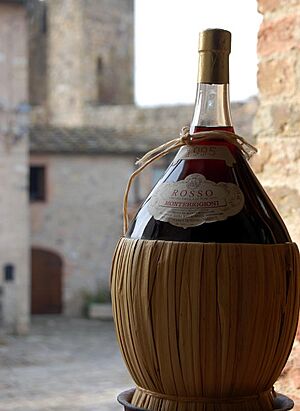Fiasco (bottle) facts for kids

A fiasco is a special kind of bottle from Italy. It usually has a round shape and is partly or fully covered with a tightly woven straw basket.
This basket is often made from sala, which is a type of swamp weed. The plant is dried in the sun and then treated with sulfur. The straw basket helps protect the bottle when it's being moved around. It also gives the round-bottomed bottle a flat base to stand on. This round shape was easier for glassmakers to create by blowing glass.
Fiaschi were also clever for shipping. You could pack them tightly by turning some bottles upside down. Their necks would fit perfectly into the spaces between the baskets of the upright bottles.
Contents
The History of the Fiasco Bottle
The fiasco bottle has a long and interesting past in Italy.
Early Mentions and Makers
The famous Italian writer Giovanni Boccaccio wrote about the fiasco around the year 1350 in his book, the Decameron. He mentioned it as a container for red wine. Old documents from that time also talk about a job called fiascaio, which meant "fiasco-maker."
Some common sizes for fiaschi back then included the quarto, which held about 5.7 liters. There was also the mezzo quarto (2.28 liters) and the metadella (1.4 liters).
When the Straw Cover Appeared
It's not exactly known when people started adding the straw covering. A painting from the 14th century by Tomaso da Modena shows a small round bottle wrapped in cords. Other artists like Sandro Botticelli and Domenico Ghirlandaio also showed fiaschi in their artworks. The oldest pieces of sala-covered bottles that archaeologists have found are from the 15th century.
Fiaschi for Everyone
Throughout history, fiaschi were used by everyone, from peasants to Popes. In 1574, a rule was made to set the exact size of the mezzo quarto bottle. A special office was even created to check the capacity of fiaschi. They would put a lead seal on the straw covering to show it was correct.
However, some producers started cheating. They would reuse the straw baskets from old, certified fiaschi on new bottles that were not the right size. To stop this, a new rule in 1618 said the seal had to be put directly on the glass bottle itself. Then, in 1621, another rule said the bottle's mouth had to be sealed with melted lead. Because of this, the straw cover had to be made shorter, leaving the top part of the bottle uncovered. This is how fiaschi still look today.
Modern Fiasco Production
By the early 1900s, making fiaschi was a big industry. About 1,000 people worked as glass blowers, and 30,000 people wove the baskets. A group for fiasco manufacturers was started in Empoli in 1933. After the 1950s, more and more of the bottle and basket making became automated, meaning machines did the work.
Around the same time, a different style of wine bottle, called the Bordeaux-style bottle, became very popular. It started to replace the fiasco. But in 1965, a law was passed that said only wines with a special quality label (called Denominazione di Origine Controllata) could be sold in fiaschi. This helped bring back the special status of this classic bottle.
Today, fiaschi are not commonly used in Italy for selling wine. You're more likely to see them as souvenirs for tourists or as decorations in restaurants and kitchens.
Features of the Fiasco Basket
The straw bands on a fiasco can be placed in different ways.
Vertical vs. Horizontal Weave
Traditionally, fiaschi with vertical straw bands were used for local markets in Italy. Those with horizontal bands had a stronger base and were more carefully woven. These were mainly used for bottles that were going to be exported to other countries. The export fiaschi often had whitened straw and were decorated with two stripes in the colors of the Italian flag: red and green.
The Base and Handles
The bottom of the basket is usually a ring made of leftover straw, tied with thin straw blades. Many centuries ago, the basket often had one or more handles made of twisted straw. Sometimes, modern fiaschi still have these handles, but usually just for decoration.
Gallery
-
Fiaschi of chianti
-
The Chianti fiasco used to celebrate the first self-sustaining, controlled nuclear chain reaction at the Chicago Pile-1 in 1942.



